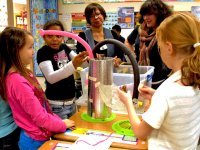Going Beyond Group Assessments for Learning
Student teamwork is integral to developing 21st-century skills, but group assessments can also serve as individual assessments by building checkpoints into collaborative activities.
Whenever announcing group or team assessments, the typical response by students and parents is "Groan." Even parents who are teachers do the same. Individual assessments are missing in teamwork. Group assessments are useful for managing a large number of students and their work. Collecting data on eight teams of four students each seems more time-efficient than assessing 32 students. Right?
The issue is that group work creates problems for knowing what each student understands and does not understand. A common complaint is that a few students do the work, while their teammates stand aside and get credit for the assessed skills. Also, parents don't want their child's grades to suffer because the group work by other students was below quality. In all of these cases, collecting group data lacks any validity for what each student knows and does not know as an individual.
For example, consider the classic group presentation at the end of a unit. If four students team up to give a ten-minute presentation, each will have about two minutes of talk-time to demonstrate a deep understanding of the unit's major concepts and skills. Given the limited time for each presentation part, demonstrating content understanding based on depths of knowledge would be shallow. In this example, the limited time is likely helpful to give feedback on demonstration of college and career readiness skills like communication and collaboration.
Eliminate assessment fog from group assessments. Consider the following guidelines for students to work in groups while checking for each individual's understanding.
Observe This Rule
Rule 1: All academic assessments are individual. Rule 2: Refer to rule 1. Follow this mantra. The result is clear data on how each student is progressing. Any data used for individual coaching or recording of grades are intentionally individual, so there can be little chance of foggy data that might misrepresent the learner's progress. Use a variety of tests, quizzes, journals, and interviews. A side benefit is that parents and students feel more confident about the work, because students have a sense of being in control of their own destiny. Prior to the group presentation, they could each write a position paper that addresses the key concepts, which is then assessed for feedback and academic recording. The team collects these papers to use for crafting the presentation. Another option is to give an exam after the group presentations. In this case, the presentations become a review experience prior to the test.
Use and Communicate Checkpoints
One value of teamwork is the mutual support that each person receives when tackling complex work and building a comprehension base. Spaced through a unit, checkpoints are formative assessment opportunities to track the growth of each student. The results are used to help those falling behind and to challenge those who need appropriate complex work. This ensures that no student falls behind for more than a day, and that no advanced learner stagnates due to lack of challenge. Break the major products into chunks based on what concepts should be understood at a given level and timeframe. Use assessments that anchor each section. Some quick assessments include:
- Exit cards
- Reflection journals
- Checklist reflections
- Non-graded quizzes
Make Work Collaborative, Not Group Tasks
Often there is "the" product that the team must craft. Even if everyone did their part, they would only know their part. In collaborative work, each student develops a draft or prototype of the product, which is turned in for individual assessment. The team's job is to take something from each person's work when forming the group's final product for a public audience. Another benefit is that as students work on their vision for the product, they can have collaborative conversations about the content and processes. Have students produce reflective learning journals about their understanding, which will document their unique perspective on the work, even when several students have similar ideas. Helpful tools include:
- Graphic organizers
- Thinking maps
- Feedback and revision team conversations
- Checklist-based team discussions
Group Work Has Value
Many schools strive to focus on preparing students for college and career opportunities after graduation. Working in teams is integral to student development of these important skills found from such sources as Tony Wagner’s work on survival skills and the P21 organization. There is broad consensus for such skills as collaboration, communication, critical thinking, creativity, and self-management. Yet content curriculum remains the emperor of instruction. Both curriculum and the benefits of teamwork can occur -- provided that the academic assessments are individually based. Otherwise, the emperor is unclothed. Turn student groans into grunts of effort by truly knowing where each student is in his or her mastery of skills and concepts, while using authentic group experiences that ready students for their post-secondary future.
